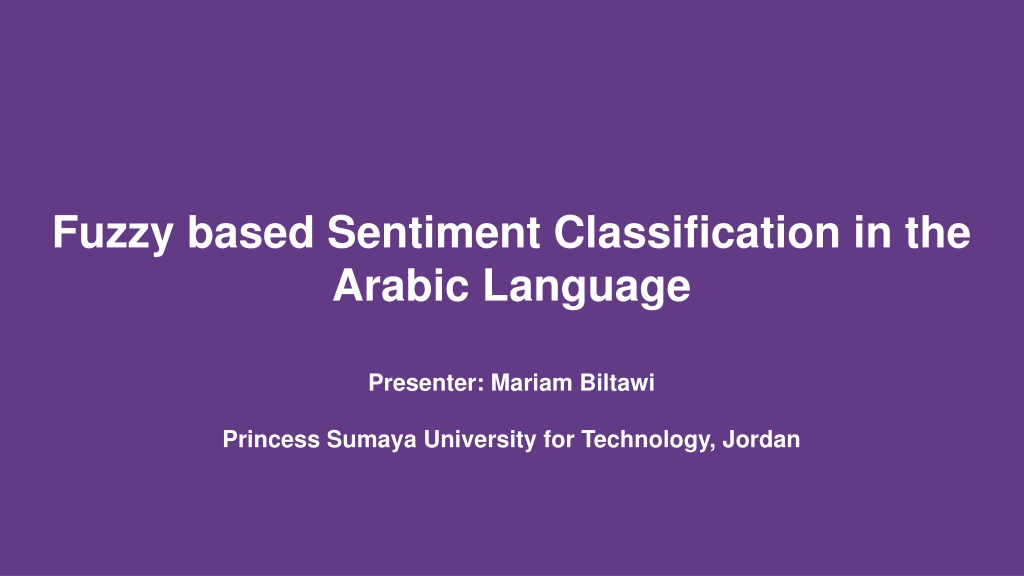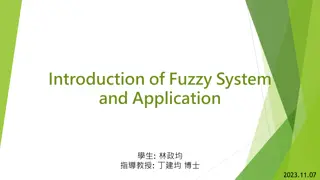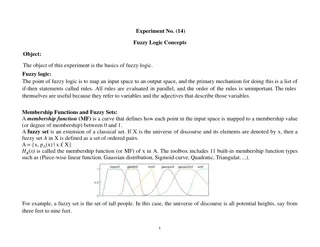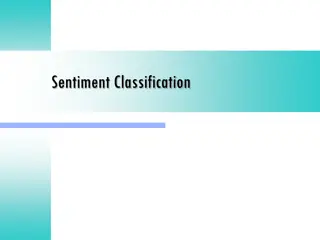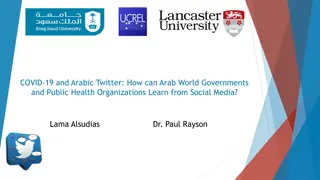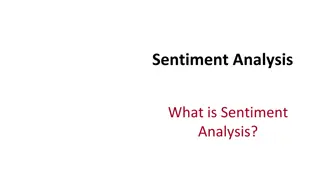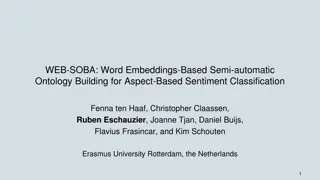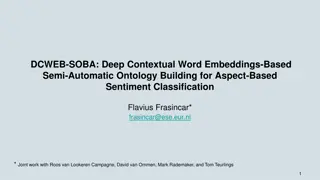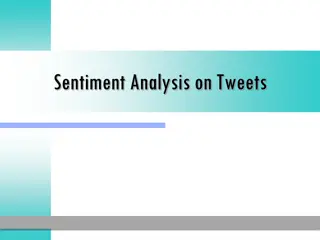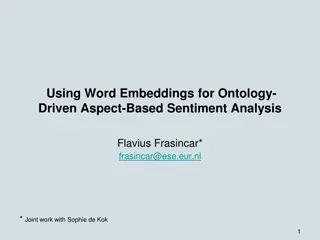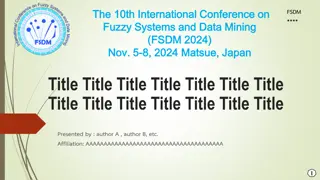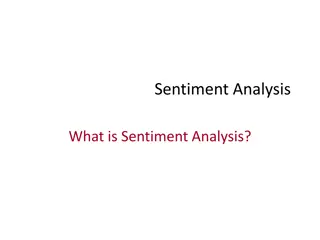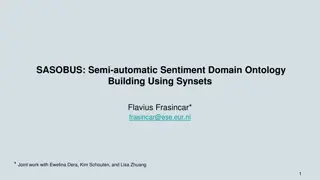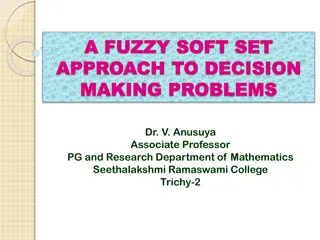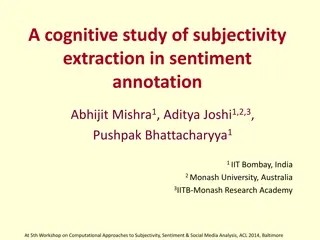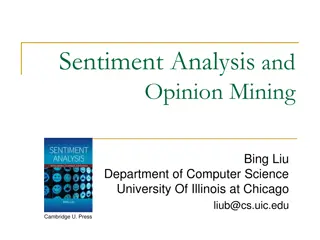Enhancing Arabic Sentiment Analysis Using Fuzzy Logic Approach
Presenter Mariam Biltawi from Princess Sumaya University for Technology in Jordan discusses a research project on enhancing automatic polarity classification of Arabic text using a lexicon-based approach with fuzzy logic. The project utilizes a large-scale Arabic book reviews dataset and a sentiment lexicon to assign weights for sentiment analysis. The proposed approach involves preprocessing steps like noise removal, normalization, and tokenization to improve classification accuracy.
Download Presentation

Please find below an Image/Link to download the presentation.
The content on the website is provided AS IS for your information and personal use only. It may not be sold, licensed, or shared on other websites without obtaining consent from the author. Download presentation by click this link. If you encounter any issues during the download, it is possible that the publisher has removed the file from their server.
E N D
Presentation Transcript
Fuzzy based Sentiment Classification in the Arabic Language Presenter: Mariam Biltawi Princess Sumaya University for Technology, Jordan
Agenda Definition Used Dataset Used Lexicon Proposed Approach Experiment and Results Conclusion
Definition Sentiment Analysis: refers to the task of identifying, individuals positive and negative opinions and emotions concerning a specific object such as an event, a product, a topic, or an individual, from a given data set.
Definition Fuzzy logic: is a computing approach based on the degree of truth rather than the complete true or false values. Fuzzy logic systems consist of five main steps: 1. Fuzzification. 2. Membership function design. 3. Design the fuzzy-rule. 4. Aggregation and accumulation. 5. Defuzzification.
Fuzzy logic in the field of Sentiment Analysis can be employed to classify the polarity of sentences or documents.
Objective This research aims to propose a lexicon based approach, using fuzzy logic to enhance automatic polarity classification of text written in the Arabic language.
Used Dataset The proposed approach is tested on Large Scale Arabic Book Reviews Dataset (LABR). LABR is a Sentiment Analysis dataset of over 63,000 book reviews in Arabic collected from Goodreads website. Review Number Positive Reviews 42,831 Negative Reviews 8,224 Neutral Reviews 12,201
Used Lexicon A large-scale Arabic sentiment lexicon (ArSenL) is used to assign weights for each token in the reviews. Each Arabic word in the ArSenL lexicon is associated with three scores: positive, negative and neutral. Each score has a value that ranges between 0 and 1. For each word, multiple results with varying scores can be found.
Proposed Approach PHASE 1
Proposed Approach Preprocessing Noise Removal Normalization Tokenization
Proposed Approach Stanford Tagger 30 tags Preprocessing Feature Extraction Two lookups were applied in case one fails: 1. Check for the token in its original form along with its POS. 2. Check for the stem of the token along with its POS. A zero weight is given when no match is found Map 30 tags into 3 main tags: Verb Noun article POS Tagging POS Mapping Weight extraction the total weight is computed for each POS tag comprising the sentence; verb, noun, and article
Proposed Approach Crisp value Preprocessing Feature Extraction Each review will have three crisp values; noun, verb, and article.
Proposed Approach Crisp value PHASE 1 PHASE 2
Proposed Approach Crisp value PHASE 1 Fuzzification Linguistic Variable Type Linguistic Values (Fuzzy set) The universe of discourse ranges from -10 to 10, which represents the weights for the words High Positive, Low Positive, Neutral, Low Negative, High Negative. High Positive, Low Positive, Neutral, Low Negative, High Negative Positive, Neutral, Negative Strong Positive, Weak Positive, Neutral, Weak Negative, Strong Negative. Verb Input Noun Input Article Input Polarity Output
Proposed Approach Membership function design Crisp value PHASE 1 Fuzzification Triangular membership functions and piece-wise membership functions are used for modeling the linguistic values for each linguistic variable.
Proposed Approach Membership function design Crisp value PHASE 1 Fuzzification
Proposed Approach Membership function design Crisp value PHASE 1 Fuzzification fuzzy rules were built in order to link the input and output variables together Linguistic Rules design Total number of rules = Number of Verb linguistic values * Number of Noun linguistic values * Number of Article linguistic values = 5 * 5 * 3 = 75 rules.
Proposed Approach Membership function design Crisp value PHASE 1 Fuzzification If (verb is highPos) and (noun is highPos) and (article is Positive) then (polarity is strongPos) If (verb is highPos) and (noun is lowPos) and (article is Positive) then (polarity is strongPos) If (verb is highPos) and (noun is Neutral) and (article is Positive) then (polarity is strongPos) If (verb is highPos) and (noun is highNeg) and (article is Positive) then (polarity is weakPos) If (verb is highPos) and (noun is lowNeg) and (article is Positive) then (polarity is weakPos) Linguistic Rules design . . .
Proposed Approach Membership function design Crisp value PHASE 1 Fuzzification Aggregation aims to aggregate the fuzzy value of each input variable in order to apply the rule. The rules used in our approach mainly use AND in their antecedent part. Aggregation and Accumulation Linguistic Rules design Accumulation aims to combine the outputs derived from all applied fuzzy rules into one fuzzy set. Here, Mamdani method is applied, which uses the maximum accumulation method to combine the outputs for each rule.
Proposed Approach Membership function design Crisp value PHASE 1 Fuzzification Aims to map the output fuzzy set into a crisp values in order to determine the final polarity of the sentence. Aggregation and Accumulation Linguistic Rules design Defuzzification Centroid defuzzification method is used
Proposed Approach Membership function design Crisp value PHASE 1 Fuzzification Aggregation and Accumulation Linguistic Rules design Defuzzification Polarity
Proposed Approach Crisp value PHASE 1 PHASE 2 Polarity
Experiment Three approaches were tested: 1. The proposed approach using the three variables; verb, noun, and article. 2. The proposed approach using only two variables; verb and noun. 3. Lexicon-based approach with no fuzzy technique. In the lexicon-based approach the same steps of phase 1 is applied on the reviews and the weight were summed at the end and checked for its polarity.
Experiment Two experiments were conducted for each approach: 1. Considering all sentiment polarities; positive, negative, and neutral; 2. Considering only two sentiment polarities; positive and negative. In the second experiment, the neutral polarity is neglected, thus as a result the number of rules used were decreased.
Experiment Number of variables Number of rules 3 5*5*3=75 Experiment 1 2 5*5=25 3 4*4*2=32 Experiment 2 2 4*4=16
Experiment (1) Results The best accuracy is given by the proposed approach and it reached: 43.28%
Experiment (2) Results The best accuracy is given by the proposed approach and it reached: 80.59%
Experimental results The proposed approach performs well when the neutral polarity is neglected,, When neutral polarity is considered accuracy decreases, because not all the words of the Arabic language is contained in the lexicon, since the proposed approach relies on the weights conducted from the lexicon.
Conclusion and Future Work Fuzzy-based Arabic sentiment analysis approach was proposed. Overall, the proposed approach outperforms the lexicon- based approach. As a future work, we are testing the algorithm on other datasets in order to perform a comprehensive comparison.
